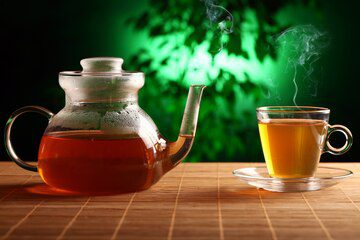Imagine a time before tea kettles when you had to balance pots on open fires to make your favourite drink. Thanks to these tabletop friends, how we drink tea has changed forever. They make steeping the perfect cup easy and handy. This complete guide details the exciting world of tea kettles, including their background, how they work, the benefits they offer, and even some valuable tips and tricks to improve your tea-brewing experience. Let go of the microwave and welcome the soft hum of a pan. It’s time to start a trip of taste and peace, one cup at a time!
The Beginnings of Tea Kettles: A Short History
The past of tea kettles is as full of interesting facts as a cup of freshly made tea. The exact start date is still unknown, but there is proof that the first versions appeared in China as early as the Han Dynasty (206 BCE–220 CE). The first pans were made of copper or cast iron and were cooked over fire. Tea and the simple pan set out on a trip around the world on trade paths. By the 1600s, tea cups were standard in European homes.
They were usually made of valuable metals, such as silver or pewter. People saw these pretty pans as signs of wealth and culture. In the 20th century, a new era for tea kettles began. As cheap and effective stovetops became more common, metal pans became mass-produced and more accessible to more people. The well-known singing pan, a beloved sign of home and warmth, also came into being.
Why steam is essential: how tea kettles work
The idea behind tea kettles is simple, but it works well. Here is a breakdown of how this critical tool for making tea works. At the bottom of the pan is a burning source that produces heat. Depending on the kettle type, this heat source could be gas, electricity, or even a fire on the stove. The water inside the pan’s body is usually made of metal or heat-resistant glass. This pot does an excellent job of moving heat from the cooking element to the water, so it boils quickly and evenly. A whistle is often built into traditional cooking pans. The whistle signals that it’s time to steep your tea. The steam from hot water sets it off.
How tea kettles can do more than heat water to a boil
The main thing tea kettles do is boil water for tea, but they can do much more. As a last resort, tea kettles can heat things. Put the steamer basket on top of the kettle with a bit of water in it. Then add the vegetables or dumplings you want to cook. The steam will simmer your food, so the proteins and tastes will stay the same. Start by adding water to your pan. After that, include your preferred spices and herbs. You may save time and effort by using your homemade broth as a foundation for soups, stews, or sauces after you’ve cooked it. Billing water in a pan is a natural and eco-friendly way to clean surfaces or tools. Baby bottles, chopping boards, and anything else that needs a thorough cleaning would benefit significantly from this.
Making the Most of Your Tea Kettle: A Master Class in Boiling
It only takes a few easy steps to maximize the use of your tea kettle. The pan’s material impacts the taste and the pan’s ability to heat food. The longevity and simplicity of cleaning that come with stainless steel make them a popular choice for kettles. Glass pans look nice and let you see the water boil. The water you use to steep your tea significantly impacts its taste. Use filtered water for a more refined taste. When making green tea, could you not bring it to a full rolling boil? The leaves can get burned. Try to keep the heat low instead. For the best taste release, black tea, on the other hand, needs to be brought to a full boil. Heating your pan with water before adding the desired amount can save you time and energy. This is especially true for electric pans.
Beyond the Basics: More Advanced Ways to Brew
People who like tea can do new things by making cold drinks. You can use your trusty tea kettle to learn how to cold brew coffee, which will let you create cool drinks with a different taste. Make your tea game better by making handmade blends. Learn how to add fruits, herbs, and spices to your tea, making it taste more complicated. Try some new tea drinks to see what they’re all about. You can make unique and tasty drinks for any event by mixing your favorite teas with spices and booze.
Tea kettles in everyday life
Tea kettles often have symbolic meanings in movies from the past to the present. Check out famous movie scenes where teapots steal the show. Literature has a long history of combining tea customs with stories. Read books where tea pans are more than containers; they become essential parts of the story. These days, tea kettles are good enough to post on Instagram. See how interested people are in visually pleasing tea pans and creative ways to serve tea online.
Tea kettles that last a long time
As concern for the environment grows, look into tea kettles made from materials that are good for the environment. Find out about environmentally friendly ways to make things that will help make the future better. The energy economy is essential for people who care about the environment. Find electric pans made with features that save energy and are better for the environment. As you sip your tea, think about how your pan will end its life. Find eco-friendly ways to recycle or eliminate old tea kettles; this will help the earth.
Hacks and Tips for Tea Kettles
Run into regular problems with your tea kettle. You can keep your pan in great shape by finding easy and quick ways to fix leaks, spots, and other common issues. Do not throw away an old pan. Find creative ways to reuse and upcycle your old tea kettle so that it becomes a valuable and stylish part of your home. Try new ways of making them to see how they compare to old ones. Try using your tea pan differently to have exciting new tea experiences.
The Future of Tea Kettles: How Technology Will Change Things
Just like technology keeps getting better, tea kettles do too. Check out new technologies that will change how we make tea at home. How something looks and how it works go hand in hand. Explore recent trends in tea pan design, ranging from future simplicity to styles that look like they came from the past. Sustainable New Ideas Sustainability is the way of the future for tea cups. Find out what new and environmentally friendly steps makers are taking to make tea kettles.
In conclusion
If you want the most excellent cup of tea every time, you need a good kettle, which is more than simply a pot. You can choose a traditional fire model, a modern electric pan, or a stylish gooseneck model. The type of pan you choose affects the taste of your tea and the whole experience as you look at the different kinds of tea pans, consider your tastes, how you like to make tea, and the type of tea you love. Finding the proper tea kettle may be a thrilling journey that will add excitement and intrigue to your tea-drinking habit, mainly because there are so many to select from.
FAQs
Is there a tea kettle that I can use for all kinds of tea?
While most kettles can be used for many types of tea, some are better for certain types. Gooseneck pans are precise for pour-over methods, and electric kettles with temperature controls can be used for different kinds of tea.
Should I clean my tea kettle frequently?
You must clean your kettle often to keep it in good operating order. Deep cleaning cooking pans once a month is suggested, while descaling electric pans more often is better.
Do electric kettles use little electricity?
Yes, a lot of new electric kettles have features that save energy. To get the most power, look for pans that can boil water quickly and turn off automatically.
Can I do something else with my tea kettle besides making tea?
Of course! You can be creative with your tea kettle. Use it to make quick meals, get hot water for cooking, or even as a stylish way to serve hot drinks.
What sorts of things are best for making a tea kettle?
What material is best for you depends on what you want. While stainless steel is strong, glass is beautiful, copper is classy, and clay gives water a unique flavour,.

